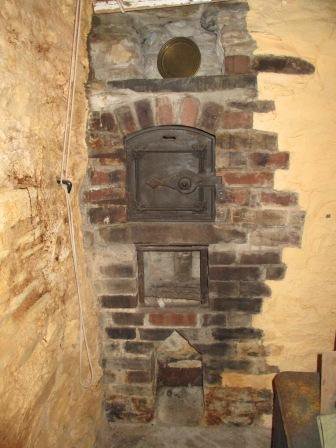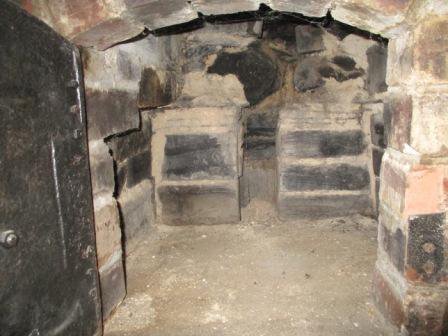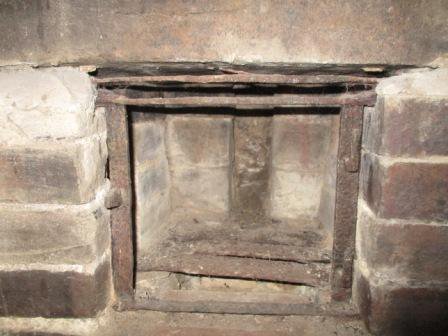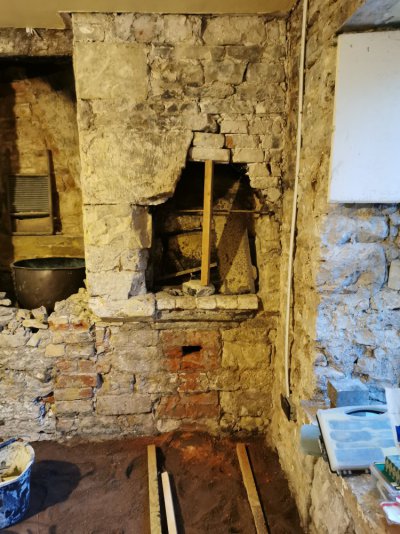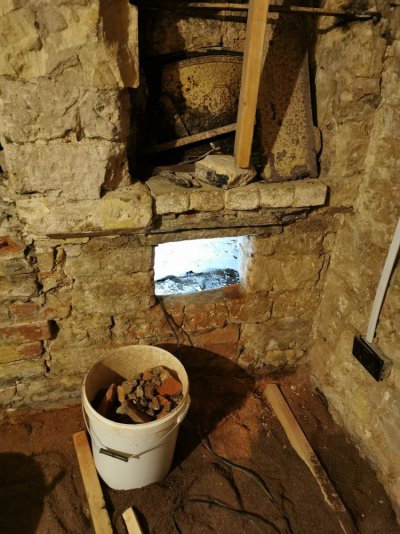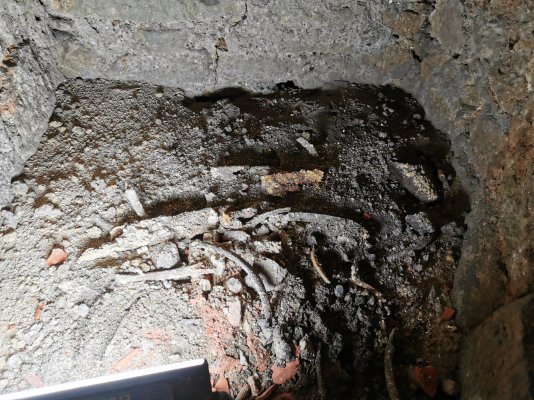CliffordPope
Member
- Messages
- 1,023
The other thread on firepace puzzle has set me thinking about our own chimney and oven in our cottage. I don't want to hijack the other thread.
What do you make of this?
There are four chambers. The top one is shallow, not connected to the flue, and appears to be just a shelf.
The lowest one is at floor level and has an iron grate at the top, connecting to a fire box above. The latter has the remains of an iron door, and has three flues - one at the back and one at each side. All three pass upwards into the third chamber, which is the largest. It has a flat smooth base, which seems to be made of some hard dense stone almost like granite, certainly not the local slate which is soft and wouldn't stand intense heat from a fire underneath.
This chamber is quite high, crudely domed inside behind the iron door, and there is a single flue at the back passing on up inside the wall, emerging about six feet higher up inside the big chimney.
Presumably this was for baking bread? But would you want hot flames and smoke passing through the actual oven? Or would you wait until the fire consisted only of burning red charcoal and the smoke had given way to hot gas? It seems a small fire chamber to produce enough heat to bring the entire oven up to temperature, so was the baking down in the hot draught, like a kind of fan-oven?
The oven is set in the wall at the back of a large "big chimney" in a small welsh cottage, and is I think original and unaltered. I have records of inhabitants in the late eighteenth century, but its actual age I don't know. When I bought it in 1985 it had been only intermittantly inhabited, used as an annexe or a store for the main house just across the road, a former farm, where we live. There were the rusty crumbled remains of a victorian range inside the chimney area, with an iron flue up into the big tapering chimney above. Judging from the smoke-blackened wall at the back of the area the original fire would have been open, on a slab or in a basket. The opening had been boarded over level with the top of the big lintel, with a hole for the flue, now useful for the insulated flue of the woodburner.
There is an access trapdoor in the ceiling and a dark and very claustrophobic chamber above inside the actual chimney. There were remains of charred wooden cross-poles presumably for hanging meat for smoking.
What do you make of this?
There are four chambers. The top one is shallow, not connected to the flue, and appears to be just a shelf.
The lowest one is at floor level and has an iron grate at the top, connecting to a fire box above. The latter has the remains of an iron door, and has three flues - one at the back and one at each side. All three pass upwards into the third chamber, which is the largest. It has a flat smooth base, which seems to be made of some hard dense stone almost like granite, certainly not the local slate which is soft and wouldn't stand intense heat from a fire underneath.
This chamber is quite high, crudely domed inside behind the iron door, and there is a single flue at the back passing on up inside the wall, emerging about six feet higher up inside the big chimney.
Presumably this was for baking bread? But would you want hot flames and smoke passing through the actual oven? Or would you wait until the fire consisted only of burning red charcoal and the smoke had given way to hot gas? It seems a small fire chamber to produce enough heat to bring the entire oven up to temperature, so was the baking down in the hot draught, like a kind of fan-oven?
The oven is set in the wall at the back of a large "big chimney" in a small welsh cottage, and is I think original and unaltered. I have records of inhabitants in the late eighteenth century, but its actual age I don't know. When I bought it in 1985 it had been only intermittantly inhabited, used as an annexe or a store for the main house just across the road, a former farm, where we live. There were the rusty crumbled remains of a victorian range inside the chimney area, with an iron flue up into the big tapering chimney above. Judging from the smoke-blackened wall at the back of the area the original fire would have been open, on a slab or in a basket. The opening had been boarded over level with the top of the big lintel, with a hole for the flue, now useful for the insulated flue of the woodburner.
There is an access trapdoor in the ceiling and a dark and very claustrophobic chamber above inside the actual chimney. There were remains of charred wooden cross-poles presumably for hanging meat for smoking.

